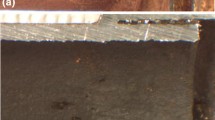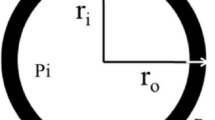Abstract
A steel wire-reinforced thermoplastic composite pipe used in an oily sewage conveying system cracked after an 8-year service. Visual inspection and microscopic observation, FTIR, density and hardness measurements, differential scanning calorimeter, gel permeation chromatography (GPC), Vicat softening temperature, and the stability of no splitting for pressed composite pipes were carried out to analyze the causes and prevent the recurrence of such cases. The results show that the size of the pipe and the wire winding met the requirements of the standard of CJ/T 189-2007, but the cracks along the axial direction of the pipe appeared on the outside surface of the pipe during the pressing test, which is like the cracks in the failed pipe, indicating that the pressure-bearing performance of the pipe decreased. The direct cause of the crack was found that due to the performance degradation of the hot glue wrapped around reinforced steel wire, cracks induced by stress first appeared in the hot glue matrix and developed in both the inner and outer layers of the PE matrix. The crack of the outer matrix allowed the corrosion and even fracture of the reinforced steel wire, resulting in a decrease in the pressure-bearing capacity of the pipe. The pipe expanded due to wire corrosion or even fracture under pressure conditions, which resulted in the further development of cracks in the inner layer matrix and, eventually, penetrated the inner layer matrix. Finally, leakage occurred.








Similar content being viewed by others
References
M. Askari, M. Aliofkhazraei, S. Ghaffari, A. Hajizadeh, Film former corrosion inhibitors for oil and gas pipelines—a technical review. J. Nat. Gas Sci. Eng. 58, 92–114 (2018)
Z. Wang, L. Zhang, T. Yu, M. Xu, Study of corrosion behavior of oil gathering facilities with CO2 flooding in low-permeability oilfields. Chem. Technol. Fuels Oils. 53, 933–942 (2018)
A. Yuli Panca, The roles of H2S gas in behavior of carbon steel corrosion in oil and gas environment: a review. Jurnal Teknik Mesin Mercu Buana. 7, 37–43 (2018)
B.A. Al Jahdaly, Y.R. Maghraby, A.H. Ibrahim, K.R. Shouier, A.M. Alturki, R.M. El-Shabasy, Role of green chemistry in sustainable corrosion inhibition: a review on recent developments. Mater. Today Sustain. 20, 100242 (2022)
E.E. El-Katori, R.A. El-Saeed, M.M. Abdou, Anti-corrosion and anti-microbial evaluation of novel water-soluble bis azo pyrazole derivative for carbon steel pipelines in petroleum industries by experimental and theoretical studies. Arab. J. Chem. 15, 104373 (2022)
C. Escrivà-Cerdán, S.W. Ooi, G.R. Joshi, R. Morana, H.K.D.H. Bhadeshia, R. Akid, Effect of tempering heat treatment on the CO2 corrosion resistance of quench-hardened Cr-Mo low-alloy steels for oil and gas applications. Corros. Sci. 154, 36–48 (2019)
H. Liu, J. Xie, M. Zhao, C. Feng, Y. Yu, G. Li, S. Song, C. Yin, Influence of Ru on structure and corrosion behavior of passive film on Ti-6Al-4V alloy in oil & gas exploration conditions (2022)
A.C.C. de Leon, Í.G.M. da Silva, K.D. Pangilinan, Q. Chen, E.B. Caldona, R.C. Advincula, High performance polymers for oil and gas applications. React. Funct. Polym. 162, 104878 (2021)
F.G. Alabtah, E. Mahdi, F.F. Eliyan, The use of fiber reinforced polymeric composites in pipelines: a review. Compos. Struct. 276, 114595 (2021)
A. Bukhari, M. Bashar, A. Aladawy, S. Goh, P. Sarmah, Review of non-metallic pipelines in oil & gas applications-challenges & way forward, in International Petroleum Technology Conference, OnePetro (2022).
Y. Bai, S. Liu, P. Han, W. Ruan, G. Tang, Y. Cao, Behaviour of steel wire-reinforced thermoplastic pipe under combined bending and internal pressure. Ships Offshore Struct. 13, 696–704 (2018)
H. Xiong, Y. Bai, Q. Fang, G. Tang, Analysis on the ultimate bearing capacity of plastic pipe reinforced by cross-helically winding steel wires under internal pressure. Ships Offshore Struct. 13, 264–272 (2018)
J. Shi, S. Zhong, X. Nie, J. Shi, J. Zheng, Study on steel wire reinforced thermoplastic pipes under combined internal pressure and bending moment at various temperatures. Thin-Walled Struct. 169, 108381 (2021)
X. Zhang, L. Hou, H. Li, G. Qi, D. Qi, Leakage analysis of steel wire reinforced polyethylene composite pipe used for waste water transportation. Eng. Fail. Anal. 130, 105750 (2021)
J. Shi, Y. Miao, X. Li, G. Li, Y. Wan, P. Lu, Investigation of failure behavior of polyethylene pipe reinforced by winding steel wires subject to inner pressure and bending, in ASME 2020 Pressure Vessels & Piping Conference (2020).
B. Wunderlich, C. Cormier, Heat of fusion of polyethylene. J. Polym. Sci. B Polym. Phys. 5, 987–988 (1967)
Y. Zhang, Y. Lin, H. Gou, X. Feng, X. Zhang, L. Yang, Screening of polyethylene-degrading bacteria from rhyzopertha dominica and evaluation of its key enzymes degrading polyethylene. Polymers. 14, 5127 (2022)
L. Kong, D. Qi, H. Li, N. Ding, P. Ge, Y. Xu, C. Zhang, C. Pan, X. Fan, Aging of polyethylene of raised temperature resistance pipe liner after a four-year service in a crude oil gathering system. J. Fail. Anal. Prev. 21, 1323–1330 (2021)
Acknowledgment
This research was funded by the National Natural Science Foundation of China (NSFC), grant number 52104072, the Shaanxi Provincial Natural Science Basic Research Program, grant number 2022JQ-559, and China National Petroleum Corporation Basic Research and Strategic Reserve Technology Research Fund Project, grant number 2021DQ03 (2022Z-04).
Author information
Authors and Affiliations
Corresponding author
Ethics declarations
Conflict of interest
The authors declare that they have no known competing financial interests or personal relationships that could have appeared to influence the work reported in this paper.
Additional information
Publisher's Note
Springer Nature remains neutral with regard to jurisdictional claims in published maps and institutional affiliations.
Rights and permissions
Springer Nature or its licensor (e.g. a society or other partner) holds exclusive rights to this article under a publishing agreement with the author(s) or other rightsholder(s); author self-archiving of the accepted manuscript version of this article is solely governed by the terms of such publishing agreement and applicable law.
About this article
Cite this article
Kong, L., Li, H., Wei, B. et al. Cracking Failure Analysis of a Steel Wire-Reinforced Thermoplastic Composite Pipe Used in an Oily Sewage Conveying System. J Fail. Anal. and Preven. 23, 389–398 (2023). https://doi.org/10.1007/s11668-023-01595-x
Received:
Revised:
Accepted:
Published:
Issue Date:
DOI: https://doi.org/10.1007/s11668-023-01595-x




